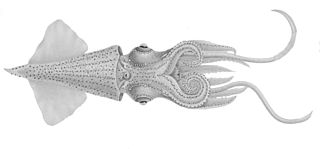
Enoploteuthidae is a family of squid comprising approximately 40 species in four genera. Most species have a mantle length ranging from 3–13 cm (1.2–5.1 in). Hooks are present on all arms and tentacles. The family is best known for the large array of photophores throughout the body.

The climbing galaxias or kōaro is a fish of the family Galaxiidae found in Australia, New Zealand, and nearby islands. The name climbing galaxias is used in Australia, and koaro or kōaro in New Zealand. Further vernacular names include short-finned galaxias, broad-finned galaxias, Cox's mountain galaxias, and Pieman galaxias.

The common galaxias or inanga is a very widespread Southern Hemisphere fish in the family Galaxiidae. It is a slim, narrow fish with a forked tail and a mottled, spotty pattern, typically about 10 cm (4 in) long when fully grown. It lives in fresh water, but spawns at river mouths and spends the first six months of its life at sea, returning en masse in spring. Its vernacular names include cowfish, jollytail, common jollytail, eel gudgeon, inaka, native trout, pulangi, puye, slippery tarki, spotted minnow, Falklands minnow and whitebait.

Tenagodus weldii is a species of sea snail, a marine gastropod mollusc in the family Siliquariidae, common name the slit worm snails. It was first described by Julian Tenison-Woods in 1876. This species is endemic to New Zealand.

Enoploteuthis is a genus of squid in the family Enoploteuthidae. The species of Enoploteuthis are most easily recognised by having a larger tail when compared to the other genera in the Enoploteuthidae. The tail's size is emphasised by not having the fins extending along its sides. In related genera there is a narrow extension of the fins along the tail. Other characteristics include the presence of suckers on the distal portion of arms IV where there at no photophores present; the tentacular club has two rows of hooks and no marginal suckers; on the buccal crown there are typical chromatophores on the aboral surface but on the oral surface there may be some light skin pigmentation. They have 9-10 photophores on the eye and they have complex photophores in the skin. In the females the Spermatangia receptacles are at the posterior junction of muscles used to retract the funnel and the muscles which retract the head. Enoploteuthis differs from other genera of the Enoploteuthidae in having two rather than three types of photophores in its integument and these are on the ventral areas of the head, funnel and mantle. All species of Enoploteuthis which have been studied have the most complex type of photophoreand seems to be a distinctive characteristic of this genus. Enoploteuthis contains the largest species in the family, attaining a mantle length of 130mm.
Pyroteuthis margaritifera, the jewel enope squid, is a species of squid in the family Pyroteuthidae.

The colossal squid is the largest member of its family Cranchiidae, the cockatoo or glass squids, with its second largest member being Megalocranchia fisheri. It is sometimes called the Antarctic cranch squid or giant squid and is believed to be the largest squid species in terms of mass. It is the only recognized member of the genus Mesonychoteuthis and is known from only a small number of specimens. The species is confirmed to reach a mass of at least 495 kilograms (1,091 lb), though the largest specimens—known only from beaks found in sperm whale stomachs—may perhaps weigh as much as 600–700 kilograms (1,300–1,500 lb), making it the largest known invertebrate. Maximum total length has been estimated between 10 metres (33 ft) and 14 metres (46 ft) but the former estimate is more likely. The colossal squid has the largest eyes of any known creature ever to exist, with an estimated diameter of 27–30 cm (11–12 in) to 40 cm (16 in) for the largest collected specimen.

Enoploteuthis leptura, the hooked enope squid, is a species of squid from the family Enoploteuthidae. It is the type species of the genus Enoploteuthis, which is in turn the type genus of the Enoploteuthidae.

Enoploteuthoidea is a superfamily of squid in the order Oegopsida.
Enoploteuthis semilineata is a species of squid within the family Enoploteuthidae known to inhabit the central South Pacific in deep-water environments. It is currently listed as 'Data deficient' by the IUCN Red List in 2010 due to little information on the species.
Histioteuthis atlantica is a species of cock-eyed squid. The species has been observer an estimated 92 times since records began, all off the coast of southern Australia, particularly near Tasmania. It was described by zoologist William Evans Hoyle in 1885.
Magnoteuthis osheai is a species of squid in the genus Magnoteuthis. The species has been observed off the coast of New Zealand.
Enoploteuthis jonesi is a species of squid from the family Enoploteuthidae. The species is gonochoric and can be found in the Pacific Ocean.
Enoploteuthis higginsi is a species of squid from the family Enoploteuthidae. The species is gonochoric, and can be found in the Eastern Pacific Ocean.
Enoploteuthis octolineata is a species of squid from the family Enoploteuthidae. The species has been observed off the coast of Kiribati in the South Pacific Ocean.
Enoploteuthis magnoceani is a subspecies^ of Enoploteuthis leptura from the family Enoploteuthidae. Some authorities consider Enoploteuthis magnoceani as being its own species, and has been observed in the Indo-Pacific Ocean.
Enoploteuthis obliqua is a species of squid from the family Enoploteuthidae. The species is rarely documented, but has been observed in the North Pacific Ocean.
Enoploteuthis chunii is a species of squid from the family Enoploteuthidae. They have been observed off the coast of Korea.
Enoploteuthis galaxias is a species of squid from the family Enoploteuthidae. The species has been observed in the North Pacific Ocean.
Enoploteuthis anapsis, also known as the starlit enope squid, is a species of squid from the family Enoploteuthidae. The species is gonochoric, and can be found in the Atlantic Ocean.







